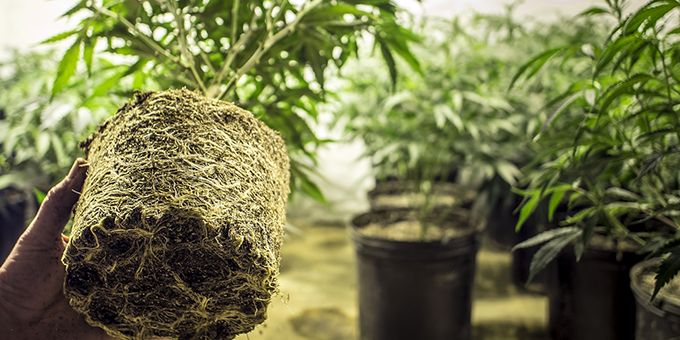The simplest way that robotic technology can be used for cannabis farming is the trimming process. AI-powered robots are able to automate the trimming process, so that farmers are able to de-leaf buds quickly and effectively, saving countless hours of manual labor.
 Robots + Cannabis Farming
Robots + Cannabis Farming

Michael Yorke | CROP Corp
How is artificial intelligence impacting robotic technology used for cannabis farming?
There are many different ways that artificial intelligence and robotic technology can be applied to cannabis farming. For example, the use of AI in sensors and high-definition cameras can be used to keep track of and adjust multiple inputs in the growing environment such as water level, PH level, temperature, humidity, nutrient feed, light spectrum and CO2 levels. Tracking and adjusting these inputs can make a major difference in the quantity and quality of cannabis that growers are able to produce. It can also help farmers know exactly how much resources they need to use for their grow operation, avoiding waste and making the process more environmentally-friendly.
Can you give us a specific scenario where robotic technology is in use for cannabis farming?
The simplest way that robotic technology can be used for cannabis farming is the trimming process. AI-powered robots are able to automate the trimming process, so that farmers are able to de-leaf buds quickly and effectively, saving countless hours of manual labor. Similarly, it can be applied to automated planting equipment to increase the effectiveness and efficiency of planting. Where it would take people hours to manually figure out optimal spacing for plants, robotic technology can quickly measure areas of land instead. Robotic technology can also help identify the sex of the cannabis plants, detect sick plants, heal or remove sick plants from the environment, and track plant growth rate to be able to predict size & yield.
Why is this kind of technology necessary for keeping up with cannabis supply demands?
The demand for cannabis plants is only continuing to grow, especially as the industry becomes more global and commercialized. However, because cannabis is still illegal on a federal level, there are many other aspects such as compliance that growers need to think about. Automation and robotic technology can lead to more accurate yield predictions, which can help farmers to ease these demands without overproducing. These predictions also allow cultivators to expand their operations while taking on less risk and maximizing efficiency. The ability to have plants monitored and attended to 24 hours a day, 7 days a week is another unique advantage over cannabis cultivators that must rely solely on manpower. It gives growers one less thing to think about as they scale their operation.
How do you expect cannabis agriculture to change over the next few years?
Technology will be able to change more than the production yield and quality of cannabis plants. Over the next few years cannabis agriculture is going to continue evolving, enabling farmers to discover new strains or tailor strains for specific effects (relaxation, excitement, increase/decrease hunger, promote creativity, etc.). It will also be able to help growers create derivative cannabis products that consumers are looking for in the market, leading to increased sales. This will be vital to the success of cannabis farmers, as the cannabis space becomes more crowded and competition for customers increases. The technology used to make more accurate predictions of yield, quality, and timing of cultivation can be used to make output and financial predictions as well, benefiting companies overall.
Do these same needs apply to other crops?
Growing cannabis is very similar to growing many other types of crops. In some ways, cannabis cultivation technology has even contributed to creating innovative farming techniques that curb agricultural waste and save on natural resources like space and water. One very well-known phenomenon that cannabis farming technology has spread into other areas of agriculture is vertical farming. This has to do with growing crops indoors, making more efficient use of the surrounding land. Vertical farming also allows for less water usage, fewer pesticides, lower fertilizer use and year-round harvests. This can result in bigger yields and even create better tasting products.
What are the pros / cons of large-scale cannabis grow operations?
Large-scale grow operations come with their own unique benefits and challenges. The good thing about them is that they allow growers to keep prices low for consumers, while improving production efficiency through technology such as automation. It also allows for a wider variety of cannabis plants to be grown, and if planted indoors, can be grown almost anywhere. On the flip side, an issue that the cannabis farming community is currently trying to tackle is water usage. Large-scale grows can require large amounts of water and energy, but technological advancement will be able to help growers have more environmentally-friendly operations. Additionally, with large cannabis farms, it can be difficult to stay consistent in quality, since there are so many plants to keep track of. The use of drones to keep track of plant health can address this problem, while saving on the hours on manpower it would take to manually check on them.
 About Michael Yorke
About Michael Yorke
Mr. Yorke began his career in the financial sector with the Royal Bank of Canada in 2001. He subsequently served as an active trader and value investor for the last 14 years. He went on to provide consulting services to several publicly traded companies in addition to organizing capital market events with On-Page Media. Mr. Yorke is fluent in three languages and is has traveled extensively around the globe. He earned an International Business Diploma, Bachelor of Business Administration degree, and is currently completing his Masters of Business Administration degree through the British Columbia Institute of Technology.
The content & opinions in this article are the author’s and do not necessarily represent the views of AgriTechTomorrow
Comments (0)
This post does not have any comments. Be the first to leave a comment below.
Featured Product

